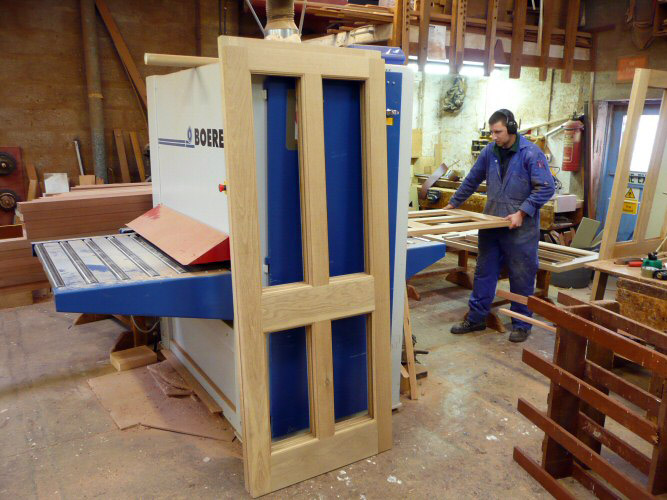Production of interior doors made of pine
Due to a number of advantages and advantages, interior doors made of solid pine have gained wide popularity. Among the advantages are the following:
1. Environmental friendliness. Interior doors made of pine have supporting certificates.
2. High level of noise insulation.
3. Low density.
4. High resistance to temperature changes and high humidity.
5. Durability.
6. Light weight.
It can also be noted that the doors made of solid wood without knots have a bright and clear pattern. This allows you to install doors in almost any room, regardless of its design and purpose. The production of doors has the ability to both tone the material and create other patterns on the surface. In recent years, manufacturers have used additional protective substances in processing, which allows to increase the service life.

The production of interior doors includes several stages, each of which is carried out under strict control:
1. Preparatory stage
2. Sawmill
3. Drying
4. Board processing
5. Splice
6. Calibration
7. Final stage
8. Additional drying
9. Packaging
Preparatory stage
The preparatory stage includes the selection of a tree that will be used as an array in the future. Here, the following qualities are evaluated::
* Cortical condition,
* Eco-friendly,
* No marriage,
* Resin concentration.
Only arrays that pass all the criteria are used in the production of doors.
Sawmill
At this stage, the trees that have passed the preparatory stage are subjected to sawing. Modern equipment allows you to make production waste-free. All waste from production is used as fuel. Due to this, the finished product has a low cost.
Drying
This stage is one of the most important. The quality of the finished product depends on how thoroughly the wood is dried. Modern drying is carried out in drying chambers, which allows you to:
* Avoid infecting wood with pathogenic bacteria and fungi that have a destructive effect.
* Get the size and shape of the finished product that will not change over time and under the influence of external factors.
* Facilitate wood splice work, as dry wood has a significantly lower weight.

Board Processing
At this stage, the masters perform the removal of all possible defects. Processing is carried out on special equipment for planing. All four sides of the board are processed. After that, the board is tested for such qualities as:
* Surface cleanliness,
* Correct geometric shapes,
* The absence of defects on the sides of the board, such as growths, cracks, knots or rotten areas.
At the end of this stage, the masters should get a board of perfect structure and shape.
Splice
After processing the boards or slats, they are spliced. For this purpose, there is a special equipment that evenly applies the glue along the entire length of the board. Then the two boards are glued together and sent for additional drying, which lasts more than 4 hours. At this stage, the wood is dried again until it is completely dry.
Calibration
This stage is similar to processing, but here cleaning is carried out already on glued boards. Calibration involves several steps::
* Elimination of excess and dripping glue,
* Roughness correction,
* Fitting the wood to the dimensions required by the manufacturer,
* Build.
Final stage
The final stage also includes several actions:
1. Assembly of the frame. In order to increase the service life of the finished product to the maximum, the assembly must be carried out with maximum accuracy and pass a test for the strength of the frame.
2. Veneer coating. This action is not necessary, but it is carried out in almost all production facilities, because it allows you to give a more aesthetic appearance to the finished product.
3. Calibration. The next calibration allows you to eliminate irregularities that may have appeared during veneering, and prepare the surface for painting.
4. Painting. Most often, materials are used for painting that do not hide the natural texture of wood, but only emphasize it and make it brighter. As a rule, a transparent varnish is used for painting, which is applied in three or more layers. This allows you to make the door surface glossy and smooth. Coloring is carried out in detail, because this method allows you to avoid uneven staining and the appearance of untouched areas.
Additional drying
Like any other material, interior doors made of solid pine must undergo an additional drying stage after painting and applying varnish. This stage included the final stage of verification. Here, the surface is checked for smoothness, absence of cracks, dents and other defects. Only a perfectly smooth and clean door goes on sale.
If the door is made with glazing, then after installing the glass, it passes another check. In this case, not only the surface of the wood is checked, but also the quality of the glass, and the accuracy of its dimensions.

Packaging
When packaging finished products, an additional assessment of their quality is carried out. At this stage, the compliance of interior doors is checked for compliance with quality standards.
The door is packed in thick cardboard and several layers of soft shrink film. This helps to avoid damage during transport. Each package contains documents confirming compliance with quality standards and operating instructions.
As mentioned above, each stage of the manufacture of interior doors made of solid pine is carried out under strict control. This allows you to avoid the appearance of defects in stores and the occurrence of defects during operation. Thus, interior doors made of solid pine – it is not only an aesthetic modern look, but also high quality and reliability.
Pub date: 2021.06.01